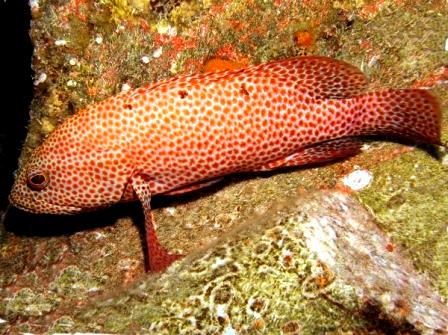




Cephalopholis cruentata
| Ecological Descriptors |
||||
| Habitat | Size (cm) | Diet | Behaviour | Sex |
| Co, R | 33 | Pisc (Cru) Noct | I | PGH |
Description:
Adult: Grey, brown or pale orange,with reddish spots on head body and fins. Has 3 pale or dark spots, white or black along base of dorsal fin. Tail highly rounded, cf similar Rock Hind and Red Hind. Can pale or darken.
Juvenile: White band runs from nape, between eyes, to lower lip.
Ecology
Inhabit rocky substrates and coral reefs and occasionally Thalassia seagrass beds from 1-170m (550ft). Solitary and secretive, they usually stay near hiding places during the day. Prefer to remain within a small area of the home range of about 2,000 m2 especially during the day. Are crepuscular/ nocturnal predators. Adults feed mainly on fishes, with preference on Brown Chromis, Chromis multilineata, juveniles feed on shrimps.
Life Cycle:
Graysby are sequential hermaphrodites, transitioning sex aged 4-5 years. Maturation begins in May, spawning usually takes place during August and September. Females mature aged 2 years, while breeding males are aged 5-7 years. There is no exact correlation of the age of the graysby with sexual transition; environmental conditions such as starvation and crowding affect the sex ratio, sexual succession and the development of the primary male gonads. A male graysby forms a harem of females, usually three females for every male. The male defends the harem from other males. The graysby release its’ gametes in the water column, where fertilization occurs. Reach 8cm by end of first year. Lays pelagic eggs hatching into pelagic larvae.
Adult: Grey, brown or pale orange,with reddish spots on head body and fins. Has 3 pale or dark spots, white or black along base of dorsal fin. Tail highly rounded, cf similar Rock Hind and Red Hind. Can pale or darken.
Juvenile: White band runs from nape, between eyes, to lower lip.
Ecology
Inhabit rocky substrates and coral reefs and occasionally Thalassia seagrass beds from 1-170m (550ft). Solitary and secretive, they usually stay near hiding places during the day. Prefer to remain within a small area of the home range of about 2,000 m2 especially during the day. Are crepuscular/ nocturnal predators. Adults feed mainly on fishes, with preference on Brown Chromis, Chromis multilineata, juveniles feed on shrimps.
Life Cycle:
Graysby are sequential hermaphrodites, transitioning sex aged 4-5 years. Maturation begins in May, spawning usually takes place during August and September. Females mature aged 2 years, while breeding males are aged 5-7 years. There is no exact correlation of the age of the graysby with sexual transition; environmental conditions such as starvation and crowding affect the sex ratio, sexual succession and the development of the primary male gonads. A male graysby forms a harem of females, usually three females for every male. The male defends the harem from other males. The graysby release its’ gametes in the water column, where fertilization occurs. Reach 8cm by end of first year. Lays pelagic eggs hatching into pelagic larvae.
Graysby
Graysby

Graysby

31



30




